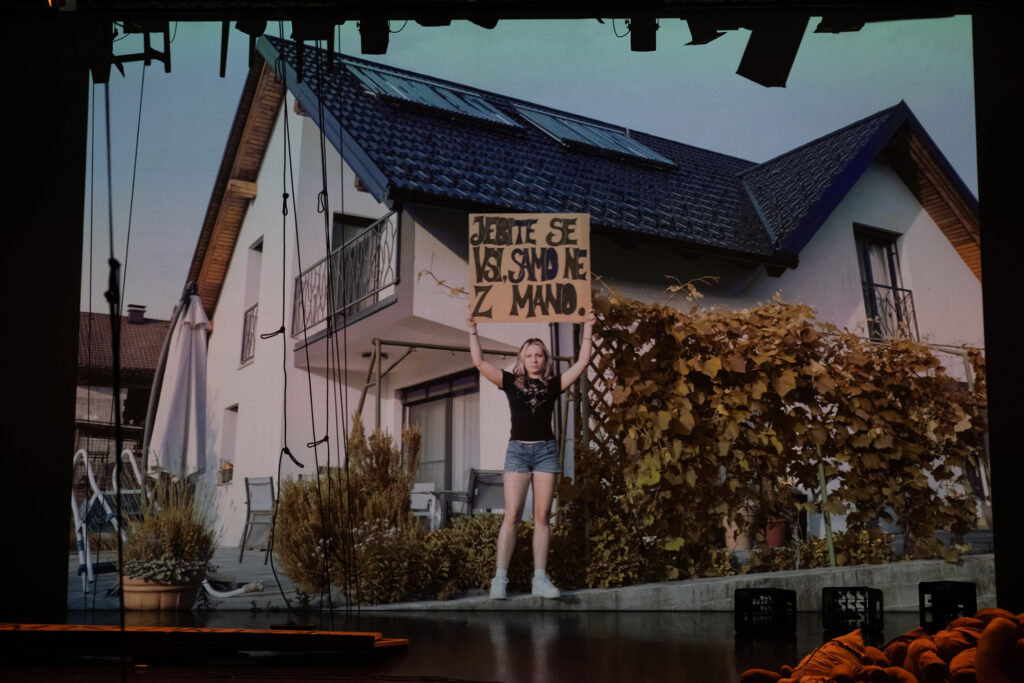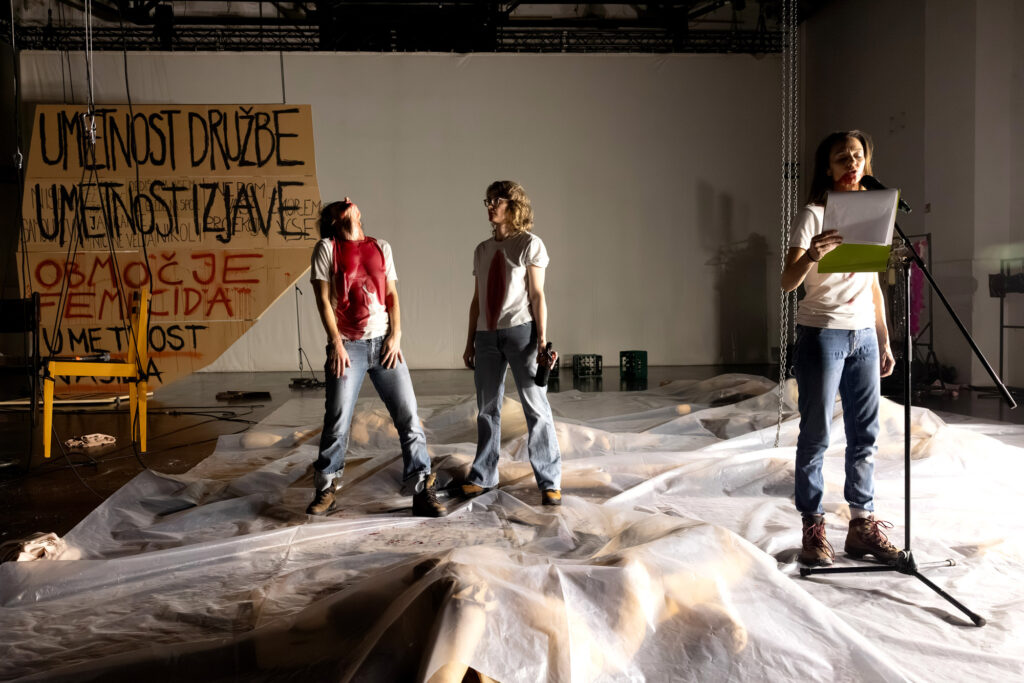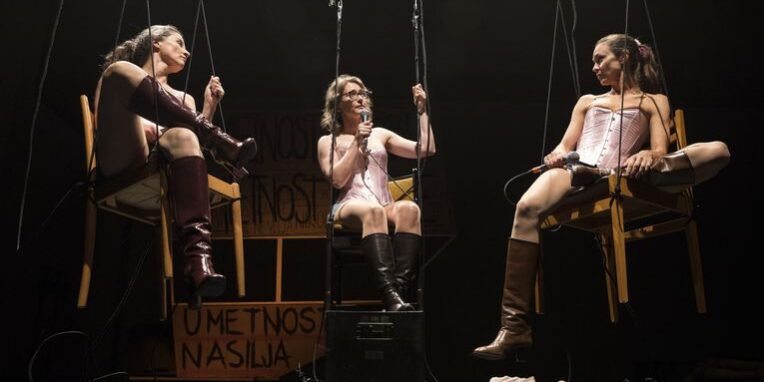Slovensko mladinsko gledališče, premiere: 10th October 2025
Over 70% of Slovenia’s territory consists of rural areas, which are inhabited by about 58% of the population. Slovenia has never had its own kingdom, and it’s even hard to speak of a long history of traditional nobility. Therefore, one could say that Slovenians have peasant origins. I can’t help but compare this to my own country. Poland during the country’s golden age about 90% of the population were peasants, and only about 10% belonged to the nobility. However, most Poles try to find traces of noble blood in their family trees, and for many years people were reluctant to admit their village roots.
A few years ago, there was a kind of “peasant turn” in Poland, which started a trend for plays, books, and films about peasant life and for celebrating it in contrast to the privileged urban elites. Barbara Kukovec’s performance Sladke skrbi can probably be seen as a “peasant play,” in which the artist creates a female safe space among rural women’s associations. In her latest performance, however, Barbara Kukovec doesn’t make the village the main topic, even though the description implies otherwise. The artist together with Katarina Stegnar and Urška Brodar, explores a new theme and returns to the village for a different reason.
Not far from the village where Barbara prepared her first performance, a woman was murdered. This event, rather than the village itself, shapes the direction of this piece. The performance opens with a video of a naked Kukovec waving a flag a made out of baby-blue fabric with a floral design while sitting on a rural house. Following this strong, artistic beginning is a scene in which we hear voices emerging from a pile composed of the actresses’ bodies mixed with plush, deformed, or dismembered female body parts.
In that pile, the performers find a knife, which reappears later when they describe the murder of the woman from the village, serving as a symbolic link between the rural part of the play and the part about violence. There are several such parts. The performance does not focus on a single topic, rather addresses a range of issues that feminism deals with; from consensual sex and micro sexual violence to the femicide. The actresses take on the roles of the Bukovec sisters. In a space designed by Meta Grgurevič and Olja Grubić, three performers, together with the musicians from Dead Tongues, begin a story that starts lightly but ends on a heavy note. The Bukovec sisters wearing shorts and boots act as a kind of narrator, an ancient Greek chorus (but a female one) who use songs to comment ironically on reality. The protagonists don’t have clearly defined personalities, rather, they narrate themselves.

Mesto žensk / City of Women 2025
Barbara Kukovec, Katarina Stegnar, Urška Brodar. Photo: Nada Žgank
The reality of the performance can be framed in several ways. The first frame and perspective we can follow is the rural one. Even though only one part of the play focuses directly on the countryside, the murder took place there, which makes the village present throughout the entire performance. And if not the village itself, then a kind of small-town atmosphere, something that even Ljubljana could represent. So this frame could be understood as something standing in opposition to a large urban metropolis. The second frame is, of course, feminist activism – the desire to educate and raise awareness – but also the feminism of the second wave, full of anger toward men. The last and, in my opinion, the most interesting interpretive frame is art itself. This frame appears in Barbara’s stories about escaping to the city, but also in her return to the countryside. The part about the murder is also presented as a form of art – described as an installation – which seems to express the need to confront patriarchy through art, just as the artists and performers Kukovec admired in London as she mentioned at the beggining of the perfromance. Art, in fact, seems to be a key word in the performance. As the play unfolds, the creators gradually reveal new inscriptions on a cardboard structure hanging from the wall: the art of society, the art of statements, and the art of violence. This is how the artists divided their performance. Interestingly, the final part about the murder is not called art, but the area of the murder…
A journey through the meanders of feminisms, Slovenian villages, and violence is now being undertaken by Barbara Kukovec, along with her story about leaving and returning to the countryside. In this part, the rural collides with the urban. She criticizes Ljubljana for hosting a feminist exhibition in 2023, pointing out Slovenia’s delayed response to feminism compared to the West. This also raises the question of Slovenia’s cultural place in the world and its peripheral status. One of the most valuable parts of the performance, however, is the film segment, in which we can admire Barbara’s return to the countryside, where she wanted to present performances to women from various communities. Performances took place in nontraditional spaces, but safe spaces, such as a village women’s club room or her cousin’s living room. The screening also includes a series of photographs taken in rural areas. They depict women standing in front of their homes, holding banners with various feminist messages. This gesture gives these women a genuine voice, rather than merely being a voice about them.

Mesto žensk / City of Women 2025
Barbara Kukovec, Katarina Stegnar, Urška Brodar – Umetnost življenja: Umor na podeželju, premiera, Stara mestna elektrarna, 10.10.2025
After this, the rural aspect of the performance comes to an end. The performers lead us out of the bubble where women gather together, learn, and experience art. We now enter the world of the art of violence, sexual and otherwise. Three actresses share their experiences, which many of the girls in the audience have likely encountered as well. These confessions form a transitional layer between the safe space of community and the act of murder. They slowly direct the audience’s attention toward the growing anger toward men and what they are capable of. The personal confessions also touch upon #MeToo issues in theatre – extremely important confessions about abusive directors who believe their position gives them unlimited power. I hope that such voices will continue to be heard more often, both in public debates and in the theatre. Soon after, violence becomes real on stage. Urška Brodar scatters boxes labeled “no,” while two other performers enter armed and begin throwing plush breasts at the audience. The final part, as I mentioned, is no longer an art piece about violence, it becomes a crime scene, a representation of femicide: the intentional killings of women and girls motivated by gender-based reasons. The installation consists of plush, dismembered or deformed bodies covered with foil, accompanied by a performative retelling of a horrific story of the murder of a woman committed by her husband and his lover. This is an incredibly thought-provoking choice. Could it mean that performance art, rather than traditional theatre, is better equipped to speak about violence? Throughout these scenes, one feels the rage and sense of injustice radiating from the artists. Perhaps that is why this part feels so powerful and overshadows the rest of the performance, its honesty and rawness make the audience lose connection with earlier sections, as the core of the performance becomes the issue of femicide.
Femicides also happen in cities and there also are men that are not educated in feminism. A good example of this are the stories of abuse from within the theatre world – a distinctly urban phenomenon. Although women in rural areas undoubtedly face also different forms of oppression, they also cultivate different kinds of feminism, such as the feminism of care. Therefore, while the topic of feminism in the countryside and the struggles of rural women certainly deserves attention, combining these two themes (Barbara’s art project in villages and the femicide) in one performance seems to create confusion for the audience. Presenting the piece as one feels unnecessary, perhaps even distracting, preventing the viewer from clearly identifying a central theme that could emerge from the performance.
Showing the femicide installation alongside earlier depictions of rural women’s communities might evoke problematic associations suggesting the countryside as a place untouched by feminism, where violence and murders of women occur. Perhaps if the performance had focused solely on the murder and developed that issue more deeply, the message would have been easier to grasp. In the end, however, we are left with intertwined perspectives that are difficult to hold onto or interpret as a whole. Maybe the simplest way to view the performance is through the lens of art itself – its necessity and its possibilities. After all, the creators chose to deal with the murder creatively, using their art to educate about femicide in Slovenia.
Creators: Barbara Kukovec, Katarina Stegnar, Urška Brodar
Co-production: Mladinsko Theatre, Rizoma Institute and City of Women
Credit: Video: Vid Hajnše//Costume design and space design: Meta Grgurevič, Olja Grubić//Music and sound: Dead Tongues//Lighting design: Borut Bučinel
For more information, visit: Mladinsko.com
Karolina Bugajak is a theater critic from Poland, currently living in Ljubljana. She studied culture and contemporary art at the University of Lodz. The title of her master's thesis was "Theatricality and Exaggeration. Camp aesthetics as a strategy for creating new identities in the plays of Grzegorz Jaremko". Her main theatrical interests include topics such as institutional criticism, the representation of marginalized groups in plays, and most recently the theater of the former Yugoslav states.








